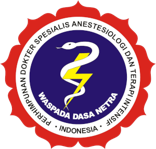Permissive Hypotension Strategy in Open-surgery of Abdominal Aortic Aneurysm
Abstract
Background: Open-surgery in patients with aortic aneurysms has always been a challenge for every anesthesiologist. The risk of massive bleeding, hemodynamic instability, and peripheral perfusion insufficiency are some of the reasons for the need of appropriate perioperative management. The purpose of this case report is to describe the permissive hypotension strategy in open-surgery of abdominal aortic aneurysm. Case Ilustration: A 65-year-old man with radiologic findings of an aneurysm in the abdominal aorta at 3rd-4th lumbar vertebrae level was planned for open-surgery aneurysmectomy and aortic graft. Pre-operative assessment concluded the physical status of ASA III. Patient was planned to receive general anesthesia. Invasive hemodynamic monitoring was performed by placing an arterial line and a central venous catheter. Just before the aortic clamp procedure, permissive hypotension strategy was started by lowering systolic blood pressure using titrated doses of nitroglycerin with target MAP of >60 mmHg. Bleeding management was carried out with intravascular fluid resuscitation until the CVP target of 7-8 mmHg was achieved. When the aortic clamp was released, titrated dose of norepinephrine was administered with target MAP of 65-75 mmHg. Post-operatively, the patient was admitted to the ICU. The patient was discharged on the seventh post-operative day. Conclusion: This case demonstrated the successful perioperative management of an open surgery aneurysmectomy by maintaining the hemodynamic stability of the patient using permissive hypotension strategy. The successful stabilization of patient’s hemodynamic state during surgery resulted in a good and fast post-operative outcome and recovery.
Keywords
Full Text:
PDFReferences
1. Anagnostakos J, Lal BK. Abdominal aortic aneurysms. Prog Cardiovasc Dis [Internet]. 2021;65(xxxx):34–43. Available from: https://doi.org/10.1016/j.pcad.2021.03.009
2. Schmitz-Rixen T, Böckler D, Vogl TJ, Grundmann RT. Endovascular and Open Repair of Abdominal Aortic Aneurysm. Dtsch Arztebl Int. 2020;117(48):813–9.
3. Gropper MA. Miller´s Anesthesia 9th Edition. 9th ed. Elsevier; 2020. 1389 p.
4. Rosebell J, Vasukinathan A, Johnson E, Durairaj P. A Case Report on Anaesthetic Management of Ruptured Abdominal Aortic Aneurysm. 2021;7(6):6–8.
5. Jaffe RA. Anesthesiologist’s Manual of Surgical Procedures 5th Edition. Philadelphia: Wolters Kluwer Health; 2014.
6. Droc I, Droc G, Buzila C, Calinescu FB. Abdominal Aortic Aneurysms (AAA): Actual approach [Internet]. New Approaches to Aortic Diseases from Valve to Abdominal Bifurcation. Elsevier Inc.; 2018. 393–402 p. Available from: https://doi.org/10.1016/B978-0-12-809979-7.00034-1
7. Butterworth JF, Mackey DC, Wasnick JD. Morgan & Mikhail’s Clinical Anesthesiology 6th Edition. 6th Editio. McGraw-Hill Education. McGraw-Hill Education; 2018.
8. Iglesias RJO, Aspi MTB. Abdominal Aortic Aneurysm in Pre-Term Pregnancy: A Case Report. Acta Med Philipp. 2021;55(7):792–6.
9. Ali J, Cody J, Maldonado Y, Ramakrishna H. Near-Infrared Spectroscopy (NIRS) for Cerebral and Tissue Oximetry: Analysis of Evolving Applications. J Cardiothorac Vasc Anesth [Internet]. 2021;000:1–9. Available from: https://doi.org/10.1053/j.jvca.2021.07.015
10. DeAngelis MC, Green MS. Anesthesia for Aortic Surgery. In: Goudra BG, Duggan M, Chidambaran V, Venkata HPK, Duggan E, Powell M, et al., editors. Anesthesiology: A Practical Approach. 1st ed. Springer International Publishing; 2018. p. 75–84.
11. Kotekar N, Shenkar A, Nagaraj R. Postoperative cognitive dysfunction – current preventive strategies. Clin Interv Aging. 2018;13:2267–73.
12. Jonsson M. Near-Infrared Spectroscopy (NIRS) as Predictor for Shunt Need During Carotid Endarterectomy. Eur J Vasc Endovasc Surg [Internet]. 2019;58(6):e9–10. Available from: http://dx.doi.org/10.1016/j.ejvs.2019.06.510
13. Abu-sinna RG, Abdelrahman TN. Comparison of the hypotensive efficacy of propofol infusion versus nitroglycerin infusion in functional endoscopic sinus surgery. Ain-Shams J Anesthesiol. 2020;12(1).
14. Tegegne SS, Gebregzi AH, Arefayne NR. Deliberate hypotension as a mechanism to decrease intraoperative surgical site blood loss in resource limited setting: A systematic review and guideline. Int J Surg Open [Internet]. 2021;29:55–65. Available from: https://doi.org/10.1016/j.ijso.2020.11.019
15. Weiner LA, Gingold DB. What Is the Role of Hypotensive Resuscitation/Damage Control Resuscitation in Ruptured AAAs? Gastrointest Emergencies. 2019;79–80.
16. Shah A, Palmer AJR, Klein AA. Strategies to minimize intraoperative blood loss during major surgery. Br J Surg. 2020;107(2):e26–38.
17. Karcioglu O. Permissive Hypotension: What’s New in Fluid Resuscitation in the Management of Hemorrhagic Shock? J Anesth Intensive Care Med. 2018;7(2).
18. Waskowski J, Pfortmueller CA, Erdoes G, Buehlmann R, Messmer AS, Luedi MM, et al. Mannitol for the Prevention of Peri-Operative Acute Kidney Injury: A Systematic Review. Eur J Vasc Endovasc Surg [Internet]. 2019;58(1):130–40. Available from: https://doi.org/10.1016/j.ejvs.2019.02.003
19. Teter K, Rockman CB, Patel VI, Chang H, Jacobowitz GR, Gelb B, et al. Mannitol Use Is Renal Protective in Patients With Chronic Kidney Disease Requiring Suprarenal Aortic Clamping. J Vasc Surg [Internet]. 2021;74(3):e214–5. Available from: https://doi.org/10.1016/j.jvs.2021.06.319
Refbacks
- There are currently no refbacks.








